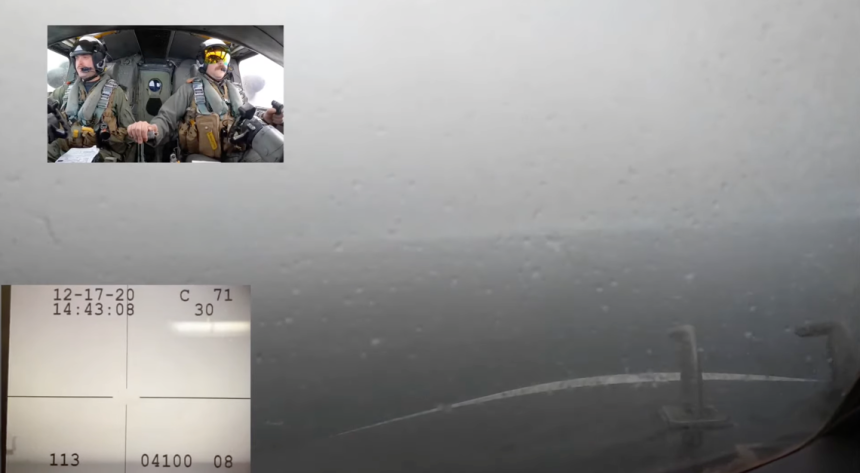Did you know that the E-2 Hawkeye is considered one of the most difficult aircraft to land on a flattop?
Each airplane has its own peculiar features and needs to be handled differently while approaching the aircraft carrier for a trap landing. Because of its wingspan of 28 m (the largest among the aircraft that are assigned to an Air Wing), the E-2C Hawkeye is a particularly difficult aircraft to land on the flight deck. Even more so at night or in bad weather, as in the video you can find below.
The clip was filmed in December 2020, during USS Theodore Roosevelt’s SUSTEX (sustainment exercise) in preparation for deployment. SUSTEX is an integrated and comprehensive exercise designed to test the strike group’s ability to successfully carry out its mission, preserve freedom of the seas, deter aggression and, if needed, fight.
Last year, the Theodore Roosevelt Carrier Strike Group consisted of Carrier Strike Group 9, USS Theodore Roosevelt (CVN 71), Carrier Air Wing (CVW) 11, the Ticonderoga-class guided-missile cruiser USS Bunker Hill (CG 52), Destroyer Squadron 23, and the Arleigh Burke-class guided-missile destroyers USS Russell (DDG 59) and USS John Finn (DDG 113).
Among the squadrons belonging to CVW-11 there were also the “Liberty Bells” of Airborne Command and Control Squadron (VAW) 115, equipped with the E-2C Hawkeye.
The footage gives an idea of the workload in the cockpit required to land the E-2 starting off “Clara” ship (unable to see glide slope, centerline, or the aircraft carrier itself) from the start (3/4 of a mile) until the in the middle (between 1/2 and 1/4 mile). At the end, as the Hawkeye approaches the fantail, below the cloud deck, the visibility improves and the flight deck becomes visible, despite some light rain.
As an E-2C NFO (Naval Flight Officer) told us when we published another clip showing a Hawkeye’s trap landing at night, “the E-2C has a spring loaded plate that, when engaged, prevents the power levers from being inadvertently retarded out of the flight range & into ground power range. During a CV landing/Touch & Go, SOP is to advance power smartly after touchdown so that the aircraft tries to fly itself off the flight deck in case of a ‘bolter’ (missed arresting wire) or a T&G. If the pilot were to retard the throttles into the ground range upon touchdown, power to sustain flight would not be available. The plane would dribble off the flight deck and end up ditching during a bolter/T&G. The power lever lock prevents this. Like a lot of aircraft mods, the power lever lock was added after a fatal E-2C CV landing mishap caused by exactly that mistake.”
Another thing that must be taken into consideration during the approach, is the aircraft’s rudder system.
“The E-2C has a complex rudder system since it needs full rudder authority at low speeds for landings and takeoffs, but at high IAS allowing the pilot to put in 20 degrees of rudder could easily cause the aircraft to exceed its max sideload capacity, with loss of control and/or aircraft failure the result. Above 150 IAS, the rudder authority is reduced from 20 to either 6 or 2 degrees by an automatic system. During the Climb checklist, the pilots will back up the Auto system by manually selecting 6-2 instead of 20. During the Approach checklist, the reverse occurs, with pilots selecting 20 again.”
Interestingly, each pilot has his own ditching hatch above his head, which is kept shut to reduce wind noise in the cockpit. The 3 NFOs share a single hatch and since they aren’t on the radios much during the approach, it’s deemed safer to remove the hatch rather than risk airframe deformation during a ditch preventing its removal after water impact.
This can be extremely important in case the cable snaps forcing the E-2 to ditch.
From the LSO (Landing Signal Officer) point of view the E-2C is also difficult to land: they consider it “an extremely tricky aircraft” which it’s better not to suggest any major adjustments to, because of the propeller-generated torque.









